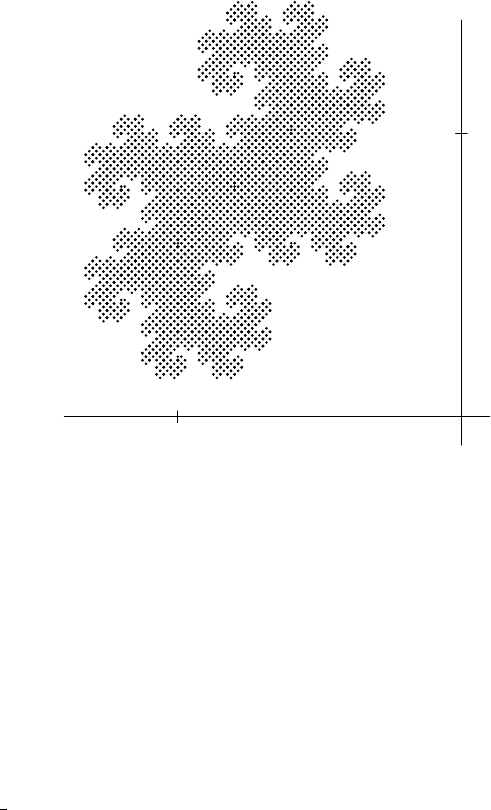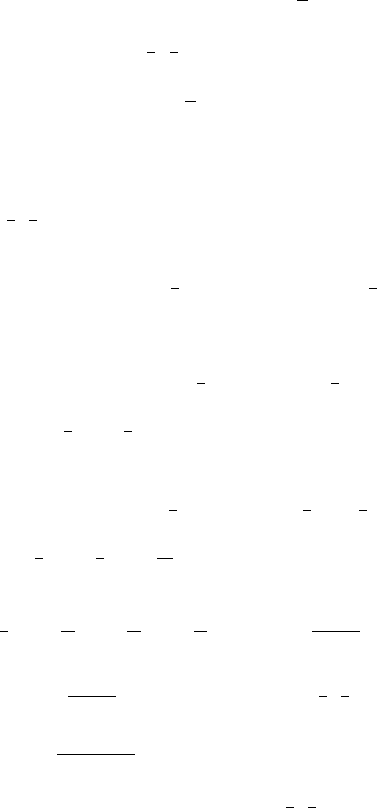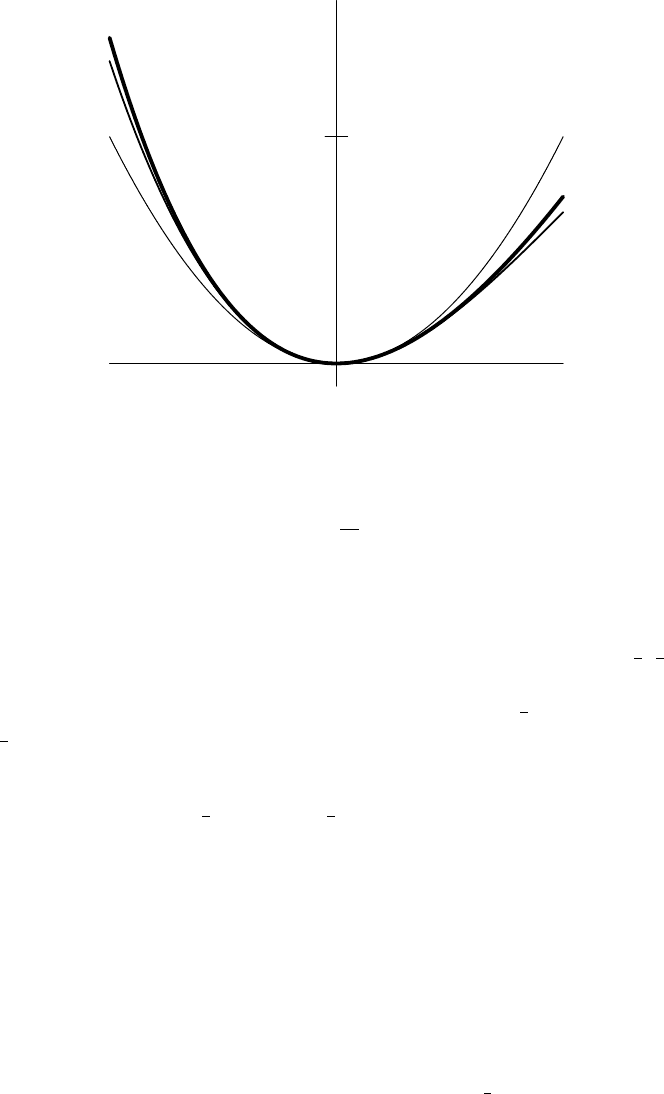Davidson K.R., Donsig A.P. Real Analysis with Real Applications
Подождите немного. Документ загружается.


11.7 Iterated Function Systems 383
Fix ε > 0 and choose N so large that s
N
diam(A) < ε. By Exercise 11.1.E,
each T
w
is a contraction with Lipschitz constant no greater than s
N
. Consequently,
diam(T
w
A) ≤ s
N
diam(A) < ε. If a ∈ A, choose a word w of length N so
that a ∈ T
w
A. Since a
w
= T
w
a
w
, it is clear that a
w
∈ T
w
A as well. Therefore,
ka − a
w
k < ε. Thus the set of these fixed points is dense in A.
Now if a is an arbitrary point in A, it follows that T
w
a belongs to A for every
finite word w. Hence O(a) ⊂ A. Observe that T
i
T
w
a = T
iw
a is another point in
O(a). Therefore, T O(a) ⊂ O(a). Let B =
O(a). The continuity of T implies that
T B ⊂ B. By Corollary 11.7.5, A =
T
k≥1
T
k
B ⊂ B. In particular A ⊂ B ⊂ A,
and so
O(a) = A. ¥
This result allows us graph the fractal approximately as follows. Pick any point
a. This may not lie in A. However, b = T
100
1
a will be very close to the fixed
point of T
1
assuming reasonable constants. Use a computer to calculate b and then
recursively plot the sets T
k
{b} for sufficiently many k. This will frequently give
an excellent picture of the fractal. You can make explicit estimates to ensure good
convergence.
11.7.7. EXAMPLE. Consider the maps
T
1
·
x
y
¸
=
·
.5 −.5
.5 .5
¸·
x
y
¸
+
·
1
5
¸
T
2
·
x
y
¸
=
·
.5 −.5
.5 .5
¸·
x
y
¸
+
·
−1
3
¸
.
A simple matrix calculation shows that (−4, 6) is the fixed point of T
1
and (−4, 2)
is the fixed point of T
2
. We use a computer to plot the sets A
0
= {(−4, 6), (−4, 2)}
and A
k+1
= T
1
A
k
∪ T
2
A
k
for 1 ≤ k ≤ 11. Since A equals the closed union of
all the A
k
’s, this yields a reasonable approximation. Look for the self-symmetry in
Figure 11.12.
We finish with a simple result that shows that the sets that are fixed for iterated
function schemes are extremely plentiful.
11.7.8. PROPOSITION. Let C be a compact subset of R
n
, and let ε > 0. Then
there is an IFS T = {T
1
, . . . , T
r
} with fixed set A such that d
H
(A, C) < ε.
PROOF. Since C is compact, we can find a finite set of points, C
0
= {c
1
, . . . , c
r
},
so that the union of the balls B
ε
(c
i
), call it B, contains C. Observe that B equals
(C
0
)
ε
. Let R be large enough so that B
R
(0) contains B. Define
T
i
x =
ε
2R
(x − c
i
) + c
i
for 1 ≤ i ≤ r.
Since T
i
c
i
= c
i
are fixed points, C
0
is contained in the fixed set A of T .
Also, T
i
B ⊂ T
i
B
R
(0) ⊂ B
ε
(c
i
) ⊂ B for each i. Therefore by Corollary 11.7.5,
A ⊂ B = (C
0
)
ε
⊂ C
ε
. Plus, C ⊂ (C
0
)
ε
⊂ A
ε
. So, d
H
(A, C) < ε as required. ¥

384 Discrete Dynamical Systems
x
−5
y
5
FIGURE 11.12. Pointillist picture of “the twin dragon” set.
Exercises for Section 11.7
A. (a) Let A
1
, A
2
, B
1
and B
2
be compact subsets of R
n
. Show that
d
H
(A
1
∪ A
2
, B
1
∪ B
2
) ≤ max
©
d
H
(A
1
, B
1
), d
H
(A
2
, B
2
)
ª
.
(b) Use induction to prove Lemma 11.7.3.
B. (a) Let T = {T
1
, . . . , T
r
} be an IFS on R
n
. Suppose that B is a compact set. Prove
that there is a unique compact set C such that C = B ∪ T C.
HINT: Add a constant map T
0
(X) = B for X ∈ K(R
n
).
(b) Hence prove that there is always a compact set C containing B so that T C ⊂ C.
C. Consider the four maps on R
2
given by T
i
x = Ax + b
i
for i = 1, 2, 3, 4, where
A =
1
2
£
1 1
−1 1
¤
and the vectors b
i
are (0, 0),(1, 0), (0, 1) and (1, 1).
(a) Show that the fixed points of the T
i
’s form the vertices of a square S.
(b) Compute T S and T
2
S.
(c) Use a computer to generate a picture of the fixed set.
D. (a) Find an IFS on R that generates the Cantor set.
HINT: Identify two self maps of C with disjoint union equal to C.
(b) Find a different IFS that also generates C.
E. Consider the maps T = {T
1
, T
2
, T
3
, T
4
} given by
T
1
·
x
y
¸
=
·
.8 .0
0 .8
¸·
x
y
¸
+
·
.1
.04
¸
T
2
·
x
y
¸
=
·
.5 0
0 .5
¸·
x
y
¸
+
·
.25
.4
¸
T
3
·
x
y
¸
=
·
.35 −.35
.35 .35
¸·
x
y
¸
+
·
.27
.08
¸
T
4
·
x
y
¸
=
·
.35 .35
−.35 .35
¸·
x
y
¸
+
·
.38
.43
¸
.

11.7 Iterated Function Systems 385
(a) Use a computer to plot the maple leaf pattern A fixed by T .
(b) Plot T
i
A for 1 ≤ i ≤ 4 to see the self-symmetries.
F. (a) Show that an isometry T with T 0 = 0 is linear.
(b) Show that every similitude T of R
n
has the form T x = rUx + a, where r > 0,
a ∈ R
n
, and U is a unitary matrix.
HINT: Set g(x) = r
−1
(T x −T 0). Verify that g is isometric and apply (a).
G. The fractal dimension of a bounded subset A of R
n
is computed by counting, for
ε > 0, the smallest number of cubes of side length ε that cover A, call it N(A, ε). The
fractal dimension is then the limit lim
ε→0
+
logN(A, ε)
logε
−1
, if it exists.
(a) Compute the fractal dimension of the unit n-cube in R
n
.
(b) Show that the fractal dimension is not affected by scaling.
(c) If A ⊂ R
n
has interior, show that the fractal dimension is n.
(d) Compute the fractal dimension of the Cantor set C.
(e) Compute the fractal dimension of the Sierpinski snowflake.

CHAPTER 12
Differential Equations
In this chapter, we apply analysis to the study of ordinary differential equations,
generally called DEs or ODEs. Ordinary is used to indicate differential equations
of a single variable, in contrast with partial differential equations (PDEs), where
several variables, and hence partial derivatives, appear. We will see some PDEs in
the chapters on Fourier series, Chapters 13 and 14.
Most introductory courses on differential equations present methods for solving
DEs of various special types. We will not be concerned with those techniques
here except to give a few pertinent examples. Rather we are concerned with why
differential equations have solutions, and why these solutions are or are not unique.
This topic, crucial to a full understanding of differential equations, is often omitted
from introductary courses because it requires the tools of real analysis.
12.1. Integral Equations and Contractions
We consider an example that motivates the approach of the next section. Start
with an initial value problem, which consists of two parts:
f
0
(x) = ϕ(x, f (x)) for a ≤ x ≤ b
f(c) = y
0
.
The first equation is the DE and the second is an initial value condition. The func-
tion ϕ(x, y) is a continuous function of two variables defined on [a, b] × R and
c is a given point in [a, b]. By solving the DE or, equivalently, solving the initial
value problem, we mean finding a function f (x) that is defined and differentiable
on the interval [a, b] and satisfies both the differential equation and the initial value
condition.
This DE is of first order, as the equation involves only the first derivative. In
general, the order of a differential equation is the highest-order derivative of the
unknown function that appears in the equation.
Because of the subject’s connections to physics, chemistry, and engineering, it
is common in differential equations to suppress the dependence of the function f
on x [i.e., to write f instead of f(x)]. Typically in the sciences, each variable has
386

12.1 Integral Equations and Contractions 387
a physical significance, and it can be a matter of choice about which is the inde-
pendent variable and which is dependent. We will sometimes do this in examples,
where simplifying otherwise complicated expressions seems to be worth the extra
demands this notation makes.
Our first step is to turn this problem into a fixed-point problem by integration.
Indeed, from the fundamental theorem of calculus, our solution must satisfy
f(x) = f(c) +
Z
x
c
f
0
(t) dt = y
0
+
Z
x
c
ϕ(t, f(t)) dt.
Conversely, a continuous solution of this integral equation is automatically differ-
entiable by the Fundamental Theorem of Calculus, and
f
0
(x) =
d
dx
³
y
0
+
Z
x
c
ϕ(t, f(t)) dt
´
= ϕ(x, f (x))
and
f(c) = y
0
+
Z
c
c
ϕ(t, f(t)) dt = y
0
.
Thus f satisfies the DE, including the initial value condition.
This integral equation suggests studying a map from C[a, b] into itself defined
by
T f(x) = y
0
+
Z
x
c
ϕ(t, f(t)) dt.
The solutions to the integral equation, if any, correspond precisely to the fixed
points of T . The Contraction Principle (11.1.6) is well suited to this kind of prob-
lem. There are also more sophisticated approaches that give weaker conclusions
from weaker hypotheses. However, the Contraction Principle gives both existence
and uniqueness of a solution, when it can be applied. Consider the following spe-
cific example.
12.1.1. EXAMPLE. We will solve the initial value problem
f
0
(x) = 1 + x − f(x) for −
1
2
≤ x ≤
1
2
f(0) = 1.
First convert it to the integral equation
f(x) = 1 +
Z
x
0
1 + t − f(t) dt
= 1 + x +
1
2
x
2
−
Z
x
0
f(t) dt
for f in C[−
1
2
,
1
2
].
Define a map T on C[−
1
2
,
1
2
] by sending f to the function T f given by
T f(x) = 1 + x +
1
2
x
2
−
Z
x
0
f(t) dt.
The solution of the integral equation is a fixed point of T .

388 Differential Equations
To use the Banach Contraction Principle, we must show that T is a contraction.
We have
|T f(x) − T g(x)| =
¯
¯
¯
Z
x
0
f(t) − g(t) dt
¯
¯
¯
≤
¯
¯
¯
Z
x
0
|f(t) − g(t)|dt
¯
¯
¯
≤
¯
¯
¯
Z
x
0
kf − gk
∞
dt
¯
¯
¯
= kf − gk
∞
Z
|x|
0
dt ≤
1
2
kf − gk
∞
.
This estimate is independent of x in [−
1
2
,
1
2
], and thus we obtain
kT f − T gk
∞
≤
1
2
kf − gk
∞
.
Hence T is a contraction.
By the Contraction Principle (11.1.6), there is a unique fixed point f
∞
that will
solve our DE. Moreover, any sequence of functions (f
n
) with f
n+1
= T f
n
will
converge to f
∞
in C[−
1
2
,
1
2
]. For example, let us take f
0
to be the constant function
1. Then
f
1
(x) = T f
0
(x) = 1 + x +
1
2
x
2
−
Z
x
0
1dt = 1 +
1
2
x
2
.
Similarly,
f
2
(x) = T f
1
(x) = 1 + x +
1
2
x
2
−
Z
x
0
1 +
1
2
t
2
dt
= 1 +
1
2
x
2
−
1
6
x
3
.
And
f
3
(x) = T f
2
(x) = 1 + x +
1
2
x
2
−
Z
x
0
1 +
1
2
t
2
−
1
6
t
3
dt
= 1 +
1
2
x
2
−
1
6
x
3
+
1
24
x
4
.
In general, we can establish by induction (do it yourself!) that
f
n
(x) = 1 +
1
2
x
2
−
1
3!
x
3
+
1
4!
x
4
−
1
5!
x
5
+ ··· +
1
(n+1)!
(−x)
n+1
.
This sequence evidently consists of the partial sums of an infinite series. The new
term added at the nth stage is
1
(n+1)!
(−x)
n+1
, which on [−
1
2
,
1
2
] has max norm
max
|x|≤1/2
¯
¯
¯
¯
(−x)
n+1
(n + 1)!
¯
¯
¯
¯
=
¡
2
n+1
(n + 1)!
¢
−1
.
Therefore, this power series converges uniformly on [−
1
2
,
1
2
] by the Weierstrass M -
test. Figure 12.1 gives the graphs of f
0
, f
1
, f
2
, and f
∞
on [−1, 1]. The astute reader
should notice that these are the Taylor polynomials for e
−x
except that the term in
x is missing.

12.1 Integral Equations and Contractions 389
y
1
1.5
f
0
f
1
f
2
f
∞
FIGURE 12.1. The first three approximants and f
∞
on [−1, 1].
We obtain
f
∞
(x) = x +
∞
X
k=0
1
k!
(−x)
k
= e
−x
+ x.
This shows that e
−x
+ x is the unique solution to our integral equation. Indeed,
(e
−x
+ x)
0
= −e
−x
+ 1 = 1 + x − (e
−x
+ x) and e
−0
+ 0 = 1.
Now the reader may notice that we only found a solution valid on [−
1
2
,
1
2
], but
in fact f
∞
(x) = e
−x
+ x is a valid solution on all of R. One way we can deal with
this is to reconsider our problem beginning at the point x =
1
2
, and try to extend to
[
1
2
, 1]. We have the DE
f
0
(x) = 1 + x − f(x) for 0 ≤ x ≤ 1
f(
1
2
) = e
−1/2
−
1
2
.
The exact same argument on this new interval will yield the unique attractive fixed
point f
∞
(x) = e
−x
+ x valid on [0, 1]. It is then easy to see that we can bootstrap
our way to the unique solution on the whole line.
In the next two sections, we show how the solutions to a largefamily of DEs can
formulated as fixed-point problems. Then we may use the Contraction Principle to
show that these DEs always have solutions.
Exercises for Section 12.1
A. Use the method of this section to solve f
0
(x) = 1 +
1
2
f(x) for 0 ≤ x ≤ 1 and
f(0) = 1. You should be able to recognize the series and successfully find a closed
form for the solution. Show that, in fact, this solution is valid for all real numbers.

390 Differential Equations
B. For b > 0 and a ∈ R, define T on C[0, b] by T f(x) = a +
Z
x
0
f(t)xe
−xt
dt. Prove
that T is a contraction. Hence show that the integral equation
f(x) = a +
Z
x
0
f(t)xe
−xt
dt has a unique solution f ∈ C[0, ∞).
C. Consider the DE f
0
(x) =
−2
x
f(x) and f(1) = 1 for
2
3
≤ x ≤
3
2
.
(a) Prove that the associated integral map is a contraction mapping.
(b) Look for a solution to the DE of the form f (x) = ax
b
.
(c) Starting with f
0
= 1, find a formula for f
n
= T
n
f
0
. Express this as a familiar
power series of logx, and hence evaluate it.
HINT: Use the closed form of the solution from (b) to guide you.
D. Consider the DE y
0
= 1 + y
2
and y(0) = 0.
(a) Solve the DE directly.
(b) Show that the associated integral map T is not a contraction mapping on C[−r, r]
for any r > 0.
(c) Find an r > 0 so that T maps the unit ball of C[−r, r] into itself and is a contraction
mapping on this ball.
(d) Hence show that there is a unique solution on [−r, r].
E. Consider a ball falling to the ground. The downward force of gravity is counteracted
by air resistance proportional to the velocity. Find a formula for the velocity of the ball
if it is at rest at time 0 [i.e., v(0) = 0] as follows:
(a) Show that the velocity satisfies v
0
(t) = g − cv(t), where g is the gravity constant
and c is the constant of air resistance. What is the initial condition?
(b) Construct the associated integral map T . Starting with v
0
(t) = 0, iterate T and
obtain a formula for the solution v
∞
.
(c) Show that this solution is valid on [0, ∞) (or at least until the ball hits the ground).
Compute lim
t→∞
v
∞
(t). This is known as the terminal velocity.
12.2. Calculus of Vector-Valued Functions
In this section, we develop differentiation and integration for vector-valued
functions. We will need this material in the next section, to convert an nth-order
DE for a real-valued function into a first-order DE for a vector-valued function.
Consider a function f : [a, b] → R
n
, where f(x) = (f
1
(x), f
2
(x), . . . , f
n
(x))
and each coordinate function f
i
maps [a, b] to R. Although much of this is done
by looking at the coordinate functions, there are some crucial differences between
R
n
and R. Most notably, we do not have a total order in R
n
, so we cannot take the
supremum or infimum of the set f([a, b]) ⊂ R
n
.
12.2.1. DEFINITION. We say that a vector-valued function f : [a, b] → R
n
is
differentiable at a point x
0
∈ (a, b) if
lim
h→0
f(x
0
+ h) − f(x
0
)
h

12.2 Calculus of Vector-Valued Functions 391
exists in R
n
. As usual, we write f
0
(x
0
) for the limit and call it the derivative of
f at x
0
. Notice that the numerator is in R
n
while the denominator is a scalar, so
f
0
(x
0
) is in R
n
.
We can define left differentiable and right differentiable in the natural way,
and we say f is differentiable on the interval [a, b] if it is differentiable at every
point of (a, b) in the sense just stated and left or right differentiable at the endpoints.
We leave it for the reader to verify that if f : [a, b] → R is differentiable at
x
0
∈ [a, b], then f is continuous at x
0
.
12.2.2. PROPOSITION. Suppose that f : [a, b] → R
n
given by f(x) =
(f
1
(x), . . . , f
n
(x)), where each f
i
maps [a, b] into R. Then f is differentiable
at x
0
∈ [a, b] if and only if each f
i
is differentiable at x
0
. Moreover, f
0
(x
0
) =
(f
0
1
(x
0
), . . . , f
0
n
(x
0
)).
PROOF. Fix x
0
∈ [a, b] and consider the function
g(h) =
f(x
0
+ h) − f(x
0
)
h
,
defined for those h so that x
0
+ h ∈ [a, b]. If g(h) = (g
1
(h), . . . , g
n
(h)), then we
have that g
i
(h) = (f
i
(x
0
+ h) − f
i
(x
0
))/h for each i. Thus f is differentiable x
0
if and only if the limit of g(h) exists as h → 0 and each f
i
is differentiable at x
0
if and only if the limit of g
i
(h) exists as h → 0. So it suffices to show that the
limit of g(h) exists and equals (u
1
, . . . , u
n
) if and only if the limits of each of its
components g
i
exists and equals u
i
. But this is established in Exercise 5.3.D. ¥
We leave it to the reader to verify that sums and scalar multiples of differ-
entiable functions are differentiable. Since products of real-valued differentiable
functions are differentiable, it follows easily from the previous theorem that if f
and g are vector-valued differentiable functions, then f · g is differentiable. Notice
that f · g is real valued.
On the other hand, not all results carry over from the real-valued setting. For
example, consider the function f : [0, 2π] → R
2
given by f(x) = (cosx, sinx).
It is easy to see that f(2π) = f(0), but there is no x ∈ [0, 2π] so that f
0
(x) is the
zero vector. However, we do have the following result. The analaguous fact for
real-valued functions is a corollary of the Mean Value Theorem.
12.2.3. THEOREM. Suppose that f : [a, b] → R
n
is continuous on [a, b] and
differentiable on (a, b). Then there is c ∈ (a, b) so that
kf(b) − f(a)k ≤ (b − a)kf
0
(c)k.
PROOF. Define v = f(b) −f (a) and a function g : [a, b] → R by g(x) = v ·f(x).
Notice that if v is the zero vector, then we are done. So we may assume kvk 6= 0.
A brief calculation shows that g is differentiable and
g
0
(x) = v · f
0
(x).
392 Differential Equations
Applying the Mean Value Theorem to g shows that there is c ∈ (a, b) so that
g(b) − g(a) = (b − a)
¡
v · f
0
(c)
¢
.
Using the definition of g and rearranging shows that g(b) − g(a) = kvk
2
. The
Schwarz inequality now gives
kvk
2
= (b − a)v · f
0
(c) ≤ (b − a)kvkkf
0
(c)k.
Dividing by the nonzero quantity kvk gives the inequality. ¥
12.2.4. COROLLARY. For a function f : [a, b] → R
n
that is C
1
on [a, b], we
have kf(b) − f(a)k ≤ (b − a)kf
0
k
∞
.
Next, we develop integration for vector-valued functions. Following the nota-
tion of Section 6.3, given P = {x
0
< . . . < x
n
}, a partition of [a, b], and a set of
points X = {x
0
j
: 1 ≤ j ≤ n} with x
0
j
∈ [x
j−1
, x
j
], define the Riemann sum
I(f, P, X) =
n
X
j=1
f(x
0
j
)∆
j
,
where the vector f(x
0
j
) is multiplied by the the scalar ∆
j
= x
j
−x
j−1
. We say that
the set of points X is subordinate to the partition P .
12.2.5. LEMMA. Given a function f : [a, b] → R
n
with f = (f
1
, . . . , f
n
), a
partition P of [a, b], and a set of points X subordinate to P , we have
I(f, P, X) =
¡
I(f
1
, P, X), I(f
2
, P, X), . . . , I(f
n
, P, X)
¢
.
We leave the proof as an exercise. The next definition says, in essence, that a
function is integrable provided the Riemann sums “eventually” converge. However,
making this precise requires several quantifiers. You should compare this definition
to Theorem 6.3.8.
12.2.6. DEFINITION. We say a bounded function f : [a, b] → R
n
is Riemann
integrable if there is a vector, v, so that for every ε > 0, there is a δ > 0 so
that every partition Q of [a, b] with mesh(Q) < δ and every choice of points X
subordinate to Q,
°
°
°
I(f, Q, X) − v
°
°
°
< ε.
As usual, we denote v by
Z
b
a
f(x) dx.
Theorem 6.3.8 shows that this definition agrees with our previous definition of
Riemann integrable function if n = 1.
